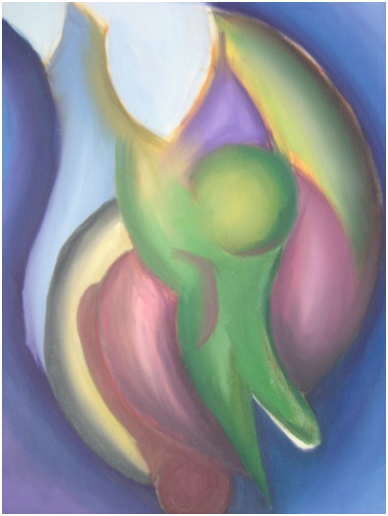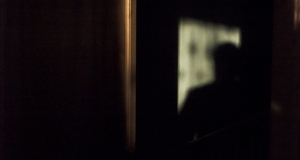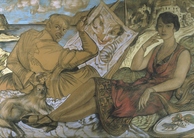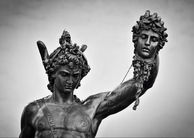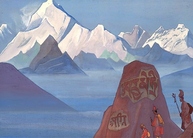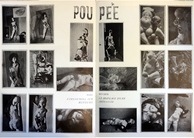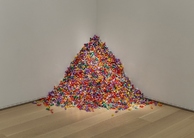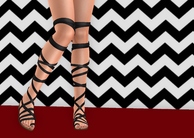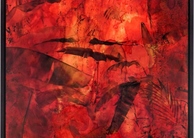From Discussions VOL. 4 NO. 1Art, Hallucination, and EmbodimentPart Two: Abstract ArtViewing abstract art is an interactive and engaging activity. The process has both a bottom up (autonomous cognitive processes influence higher order thinking)20 and top down (higher order thinking drives the autonomous processes)21 aspect. The bottom up approach to perception has been analyzed by Rudolf Arnheim, David Marr, and Gestalt Psychology. The theories presented by these paradigms will be summarized and applied to the viewing of abstract art. These models will be further elaborated on by including a top down element that drives perception based upon meaning attributed to a scene. Arnheim proposes a theory of art perception that is largely based upon what he has termed "psychological forces.‟ These are forces that arise from the physical qualities of elements on a page. He thinks that certain placement, size, shape, and relationships between elements directly affects the perceptual process, inducing tensions and weights stemming from a given arrangement.22 For example, if a circle is placed slightly off center, it will then create a greater unease in the observer than if the circle was placed much off center.23 This, he claims, is not a higher order process of evaluating the scene and making a response based upon thought, but rather a gut reaction; there are certain qualities on a page which are inherently pleasing or displeasing to the human perceptual processes.24 Marr has created a strict bottom up approach to perception that is based upon a computerized object recognition paradigm. This is a modular process which relies largely on a computer being able to recognize sharp value changes and noting these areas as most important.25 This process is employed for a whole image to produce what he calls a "raw primal sketch.‟26 This sketch consists of the crucial areas in an image that has significant value changes. This raw sketch then goes onto the next module further refining the sketch by techniques to produce a more information laden "full primal sketch.‟27 This entire process produces a schematic replication of the original image. The next step, which addresses object recognition, applies gestalt rules in order to group objects based upon the principles of Gestalt psychology. Gestalt psychology proposes a theory of grouping objects based upon general principles extracted from rigorous experimentation on the nature of human perception. These principles are: the law of proximity (close features will be grouped), the law of similarity (objects of similar form will be grouped), the law of good continuity (objects that demonstrate a certain smoothness will be grouped as one), the law of closure (gaps will be filled in if a figure appears as a coherent object), and the law of Pragnanz (the most notable and stable geometric form will be chosen).28 Multiple layers of perception occur when one views abstract art. At the base, one has the psychological forces described by Arnheim. Certain elements of the piece, such as balance and flow are simply felt. No higher order interpretation is needed for this to happen. This analysis of different layers of perception will be aided by a concrete example. Figure 1 shows a work composed by the author of this essay. Arnheim thinks that darker colors have less "visual weight‟ than lighter colors, and also that the bottom of the page is weighted heavier than the top.29 Hence, this image would be balanced according to those terms because the bottom is darker than the top. The same is true for the two circles in the image. The bottom circle would normally have more weight, but its darkness creates a sense of balance with the lighter circle. These forces all act at a very low level of perception, he claims, without the aid of higher order thinking. The green form in the center of the painting exhibits the law of similarity and continuity. The form is one coherent and continuous color, which leads the viewer to perceive this as one object. The blue background, although it is interrupted by the dark circle at the bottom, is perceived as one coherent frame because the color is similar throughout. Motivating these gestalt principles would be Marr‟s approach of detecting various light intensities. Each object in the piece has a different light intensity which would be noted by his program and sketched out in the raw and full primal sketch. The gestalt principles would then be applied to arrive at coherent objects within the image. Figure 1
In addition to the above analysis, the attribution of meaning to the art piece will influence one‟s perception of it. One could look at this piece, either alone or with another person, and say that the green figure in the middle looks like a body with the light blue region being the head. This would follow the law of Pragnanz because a body is a very stable shape that one is accustomed to seeing. However, this is gestalt grouping based upon higher order thinking. Gestalt psychologists hold that all of their laws appear only in bottom up perception, without any thought. However, Gestalt principles may be active on both levels of perception after one attributes meaning to a scene. Moreover, once this higher level Gestalt grouping takes place, it seems that another level of psychological forces arise, leading to a narrative interplay between the elements on the page. The human figure seen can be said to hold more visual weight, thus redistributing the psychological forces, therefore altering the physical perception of the art piece. It is in this way that viewing abstract art can be likened to a hallucination. The meaning ascribed in this process influences what one perceives to be on the page. The perception is now altered and it would be hard to view this piece again without seeing the green form as a human body. This is the parallel with the Christ figure. Although what is seen is only a person clad in white, or a green form, the perception is based upon the interpretation. The perceptual experience of the observer is altered according to the meaning assigned to the object in the world. The viewer of the art piece is seeing something in reality that is not necessarily there. This would fall under the definition of a hallucination. There may be a modular process of bottom up perception as Marr puts forward, and psychological forces and Gestalt principles may be at work in this process, but there is also another level of perception that has to do with the meaning assigned to an object. Elements on the page are regrouped to arrive at this new meaning, and that grouping has its own set of psychological forces that motivate deeper meaning to a piece. This newfound meaning may even motivate another sequence of grouping based upon further reflection of the meaning of the piece, and this cycle will continue until the participant ceases to contemplate the piece at hand. At every stage of this regrouping, the perception of the piece is varied. The physical perception, meaning what is actually seen and comprehended, varies with respect to the degree of meaning associated with the piece. The viewer induces different levels of hallucination based upon the meaning assigned to the piece. Following this argument would be that claim that experiencing a drug induced hallucination is like interpreting the world as an abstract art piece. As Shanon states, referents in the world are seen as metaphorical, they are not perceived as what is actually there; they are only a suggestion, a guide, a conduit for perception which is based on the meaning assigned to the metaphorical object. Altering certain aspects of the previous theories allows for this to happen. Elements in the world are grouped in a bottom up manner, but this is not where the process ends; it continues based upon the meaning assigned to the scene at hand. This meaning then evokes a second order grouping which alters the perception of the individual, thus creating a subjective perception of things in the world that do not exist objectively for everyone, a phenomena also known as a hallucination.Continued on Next Page » Suggested Reading from Inquiries Journal
Inquiries Journal provides undergraduate and graduate students around the world a platform for the wide dissemination of academic work over a range of core disciplines. Representing the work of students from hundreds of institutions around the globe, Inquiries Journal's large database of academic articles is completely free. Learn more | Blog | Submit Latest in Visual Arts |

